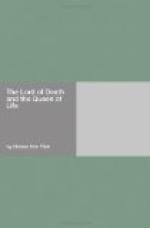“We’re fools! Blind, blithering idiots—that’s what we are!” He pointed toward the ceiling with a hand that trembled plainly, and went on in a voice which he tried to make fierce despite the awe which shook it.
“Look at that dust again! How’d it get there?” He paused while the others, the thought finally getting to them, felt a queer chill striking at the backs of their necks. “Men—there’s only one way for the dust to settle on a wall! It’s got to have air to carry it! It couldn’t possibly get there without air!
“That dust settled long before life appeared on the Earth, even! It’s been there ever since the air disappeared from Mercury!”
IV
THE LIBRARY
“I thought you’d never get back,” complained the doctor crossly, when the three entered. They had been gone just half an hour.
Next moment he was studying their faces, and at once he demanded the most important fact. They told him, and before they had finished he was half-way into another suit. He was all eagerness; but somehow the three were very glad to be inside the cube again, and firmly insisted upon moving to another spot before making further explorations.
Within a minute or two the cube was hovering opposite the upper floor of the building the three had entered; and with only a foot of space separating the window of the sky-car and the dust-covered wall, the men from the earth inspected the interior at considerable length. They flashed a search-light all about the place, and concluded that it was the receiving-room, where the raw iron billets were brought via the elevator, and from there slid to the floor below. At one end, in exactly the same location as the desk Smith had destroyed, stood another, with a low and remarkably broad chair beside it.
So far as could be seen, there were neither doors, window-panes, nor shutters through the structure. “To get all the light and air they could,” guessed the doctor. “Perhaps that’s why the buildings are all triangular; most wall surface in proportion to floor area, that way.”
A few hundred feet higher they began to look for prominent buildings. Only in forgetful moments did either of them scan the landscape for signs of life; they knew now that there could be none.
“We ought to learn something there,” the doctor said after a while, pointing out a particularly large, squat, irregularly built affair on the edge of the “business district.” The architect, however, was in favor of an exceptionally large, high building in the isolated group previously noted in the “suburbs.” But because it was nearer, they maneuvered first in the direction of the doctor’s choice.
The sky-car came to rest in a large plaza opposite what appeared to be the structure’s main entrance. From their window the explorers saw that the squat effect was due only to the space the edifice covered; for it was an edifice, a full five stories high.




